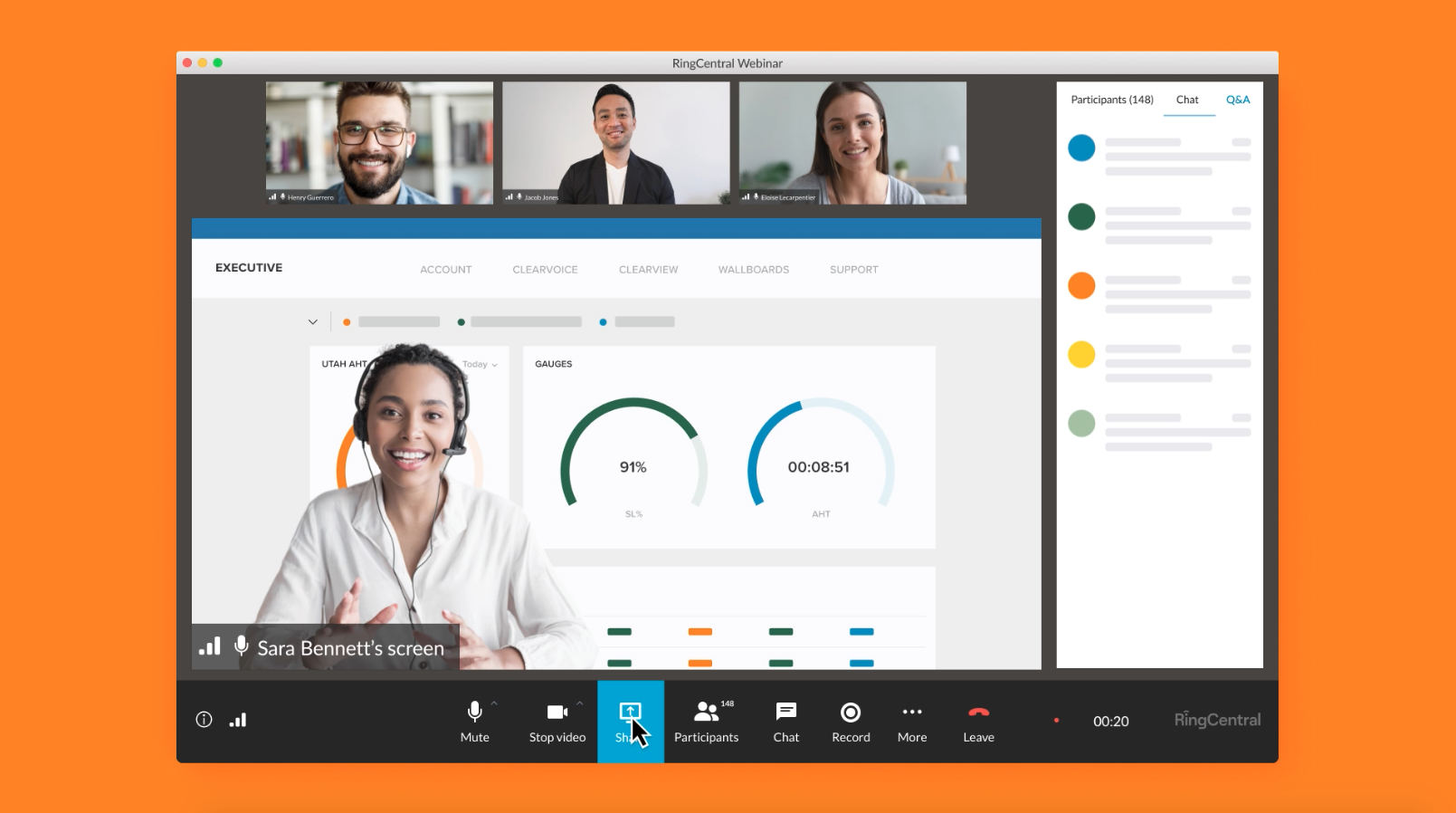Hopin is now RingCentral Events
The click-clacking of keys on a calculator. Endless rows of Excel, scrolling away into oblivion. The stress of wondering if the numbers will end up in a negative or positive. What image comes to mind? For many, this is the typical scene for creating a budget.
But the burden of an event budget does not have to invoke feelings of stress and anxiety.
Event budgeting tools have advanced and it is now easier than ever to get accurate estimates.
And while it’s as important to create a thorough, accurate budget, it’s not something that has to eat up your time or your sanity.
Building a successful budget can seem like an Everest-sized mountain with the hardest part being where to start. And it’s extra hard to navigate when you’re not even sure where base camp is.
Good news: we’ve outlined seven simple steps to create an all-encompassing event budget to help you up the mountain:
Step #1: Focus on your event strategy and goals
Step #2: Document your core event costs
Step #3: Make room for event marketing
Step #4: Add in experiential extras
Step #5: Factor in your technology
Step #6: Capitalize on revenue opportunities
Step #7: Become an event ROI rockstar
Streamline your event budgeting process
Step #1: Focus on your event strategy and goals
Before diving into the event budget, it’s important to lock down a strong event strategy. Without one, it can be difficult to make key choices to shape your budget.
An event strategy will encompass your overall vision for the event, along with goals and objectives on how to get there.
If this is your first time outlining an event strategy, check out a few sample goals below:
- Attracting new prospective clients and/or deepening existing customer relationships
- Increasing employee engagement, reinforcing cultural values, and/or fostering collaboration
- Driving brand awareness and/or establishing your company as a thought leader in your space
If this is an event you’ve planned before, look to past events’ budgets and:
- Evaluate the costs and revenue streams to get baseline estimates
- See where you underestimated or overestimated to avoid making the same mistakes this time around
Step #2: Document your core event costs
Some of your costs will be determined by the format of your event. For instance, a virtual event won’t necessarily require on-site health and safety measures, but an in-person one might.
Other in-person and hybrid event cost categories can include:
- Food and beverage
- Venue and rentals
- Signage and decor
- Travel and lodging
- On-site check-in and badges
- A/V and live streaming services
But whether your event is in person, virtual, or hybrid, there are a core set of costs you’ll need to consider:
- Speakers and hosts
- Branding and design
- Music and entertainment
- Agency or event planner fees
- Staffing
If there isn’t a ballpark budget to start with, one can be built from scratch using industry standards and vendor quotes which you can get online or over the phone. This will give you a rough idea of how much money will be needed to achieve the event goals.
Pro tip: Include a contingency budget
When setting your ballpark budget, add some extra cushion — around 10-20% — to serve as your emergency fund. This way, if an unexpected cost comes up, you’ll already be covered.
Step #3: Make room for event marketing
It’s difficult to host a successful event without buzz. The revenue generated from ticket sales is often the main driver of income, so budgeting to get the word out will be an important step. Whether that’s through social media, design, or traditional advertising, your budget must include a space for promotion and marketing.
Event website management: Budget for a digital homepage for your event. This is where attendees can register and get up-to-date information on all event details.
Email marketing tools: 87% of marketers use email to distribute their marketing content, which includes promoting their upcoming events. Look for a tool that integrates into event registration systems and can automatically send reminders and updates.
Graphic design services: The right branding can make an event stand out, showcase an organization’s values, and get the audience excited about attending.
Content creation resources: You’ll likely need a variety of content for your event, from materials for your presentations to marketing materials like blog posts and social media campaigns.
Online advertising: There are many popular types of online advertising –– from search engine marketing (SEM), which are the ads you see at the top of a Google search, to display advertising, or clickable banner ads. Whichever type you choose, you’ll want to budget enough to get your event in front of your ideal audience.
Public relations fees: Not every event will need a PR team. But if you’re dealing with high-profile speakers or if you want to get extensive media coverage of your event, you might want to look into a PR professional to pitch your event and handle any media inquiries.
Direct mail campaigns: Sending a physical promotion might feel old-school, but it can make your event stand out. Note that quality materials can come at a premium but will reflect the quality of the event to come.
Influencer promotions: Paid influencer marketing can help generate buzz for events, create content to reuse in secondary marketing campaigns, and improve brand positioning with their target audiences. With 75% of brand marketers planning to engage influencers, it’s something to consider when budgeting.
Step #4: Add in experiential extras
In 2021, 29% of marketers invested in experiential marketing — and that number continues to grow, as the industry recognizes the brand-building power it holds.
If you seek to create surprise-and-delight moments and deeper emotional connections with your attendees, you’ll need your budget planning to include experiential marketing.
Experiential events can be small and intimate or large and loud, but it’s the thought and detail behind the investment that makes the difference. For a few ideas, see below:
- Swag: Physical or digital freebies can delight attendees, serve as advertisements, and keep your event front-of-mind even once it’s over. This is great for virtual, hybrid, or in-person events as people love free stuff — and it pays off for companies in the long run.
- Contests and giveaways: You can drive traffic to your event or your sponsors’ booths with giveaways, as free prizes boost signup rates by up to 61%.
- Celebrity appearances: Booking someone famous to attend or even host your event can make a big impact on attendance and audience experience.
- Materials for workshops: This line item will be event-specific. Do you need to invest in data visualization software to make custom charts for your workshop session? Or, if you have a hands-on component at your event, do you need to buy physical materials?
- Photo booths: Improve the attendee experience with a physical or digital photobooth that can serve as an icebreaker, a generator of super-shareable content, and a memorable part of their take-home swag.
- Yoga, meditation, or mixology classes: Break up a long agenda with hands-on classes that get your audience moving, breathing, or drinking (or all three).
- VIP accommodations: Whether your VIPs are ticket holders who shelled out for a red-carpet experience or industry superstars you want to impress, you might need the budget to invest in top-notch accommodations for them, like five-star hotels or luxury rentals.
Step #5: Factor in your technology
Whether your event is onsite, virtual, or hybrid, you’ll need event technology to support it.
Look for an event platform that eliminates additional expenses to drive efficiencies. Ideally, you will want to find a virtual or hybrid platform with the following features and integrations:
- Integrated event websites: You definitely need a landing page for your event. Seek out platforms that automatically integrate with event registration and tracking rather than paying a web developer to design something for you.
- Registration tools: A common need is custom registration flows and forms, ideally self-coded.
- Email communications: Email marketing can drive $36 of revenue for every $1 invested. Whether you use email to publicize your event or just to communicate with attendees, you’ll need software to help you write, design, send, and track emails.
- Virtual sponsor booths: Your sponsors signed up for your event for a reason, whether that was to collect leads or improve brand recognition. It is thus important to make sure they have a platform that’s engaging and customizable.
- Online venue for attendees: A well-designed virtual venue can be just as engaging as a physical one, and can level the playing field for virtual attendees at hybrid events by giving them a space that facilitates exploration, networking, and engagement.
- Live streaming software: To connect with your at-home audience, you’ll need software that turns your event backstage into a broadcast production studio, with a greenroom, customizable video layouts, and more.
- Mobile app: For hybrid events, a mobile event app can bridge the experience for in-person and online participants, allowing them to explore the venue, participate in polling and chats, and more easily network with other attendees.
And for on-site events, consider extra tech costs like:
- Physical vendor booth costs: Are you asking vendors to provide their own, or are you supplying a base?
- Lighting, microphones, and A/V equipment: Set your presenters up for success with quality tech, otherwise, attendees could miss some key moments from your speakers.
- On-site branding and decoration: A budget for decor to make your space stand out will be something to look into, whether it’s banners, stages, welcome signs, or beyond.
- Lead retrieval for exhibitors: Data and analytics are key for sponsors. If sponsors are expecting a return on investment (ROI) on your event’s lead-generating potential, you may want to provide them with software that tracks this data easily.
- Attendee check-in kiosks: Streamline the start of your event with technology that makes check-in a breeze.
- On-site badge printing: If you invest in on-site badge printing, you can avoid the stress and waste of typos or creating badges for no-shows.
Now that you have a good sense of all your expenses, it’s time to round out your budget by including your potential revenue opportunities.
Step #6: Capitalize on revenue opportunities
With the budget starting to turn into a fair estimation of actual costs, it’s time to look at the potential revenue sources to balance it out.
First, consider paid tickets.
Ticket sales can be boosted by offering different ticket types:
- Early bird discounts: Play into the sense of urgency by offering a better deal if attendees buy before anyone else. It’s worth offering a steep discount to have a locked-in, engaged audience.
- VIP or premium add-ons: Creating extra value lets you charge extra for tickets. This can be in the form of one-on-one sessions with your expert speakers, a special cocktail hour for VIPs only, or luxe accommodations.
- Referral programs: With the help of referral software, you can turn your attendees into brand ambassadors, offering them a discount on their own ticket for referring friends.
Second, you can look for sponsors to offset costs or become profitable.
Sponsors invest in events to gain access to your audience. In exchange for paying for part of your event, these stakeholders will be able to boost their image, generate interest in their product, or increase their exposure and brand awareness.
Event sponsorship looks different as events now need to be able to offer true collaboration and data-driven proof of sponsors’ ROI.
Third, you can sell merchandise or products at your event. Whether you’re creating custom event merchandise or simply making your products available for sale, include a line item in your budget that estimates the revenue from these sales.
After estimating revenue from paid tickets, sponsorship, and sales, update your budget.
As the money flows in, keep your budget up-to-date to see how close you’re getting to achieving your desired revenue targets and to attaining event ROI.
Step #7: Become an event ROI rockstar
By now, you should feel confident about this process. You’re long past base camp — you’re close to the top of your event-budgeting mountain.
All you need to reach the summit is to calculate the ROI of your event.
To calculate ROI, follow this simple formula:
[(Total Revenue) ÷ Total Cost of the Event] = ROI
Run the numbers. If you come up with a 1, you’ve broken even on your event. Seeing a 2 or 3 means you’ve generated a profit that’s two-to-three times your costs.
For example, your ROI from a tech conference with paid tickets and sales might look like:
[($10,000 in ticket sales + $100,000 in sponsorships + $2,500 in merch sales) ÷ ($80,000 total expenditure on event)] = 1.4
An ROI of 1.4 means that for every $1 invested in your event, you got $1.40 back.
Streamline your event budgeting process
Use this guide and this event budget template to take the pain out of event budgeting and master the process.
Make everything even easier the next time around by evaluating your budget after each event to identify any overages or savings. Then use those insights to make future event budgets even more accurate and reliable.
Once you nail down your budget, you can confidently forge ahead with planning and hosting an unforgettable event.
Interested in including RingCentral Events’ leading event management platform in your event budget? Contact our team of experts to learn more today.
Originally published Sep 01, 2022, updated Oct 20, 2024





